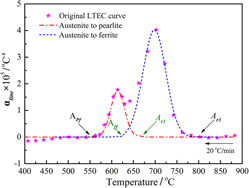Crossref Citations
This article has been cited by the following publications. This list is generated based on data provided by
Crossref.
Ren, Qing-Qiang
Baik, Sung-Il
An, Dong
Zhu, Mingfang
Krakauer, Bruce W.
and
Seidman, David N.
2020.
Atom-probe tomographic and dilatometric studies of phase-transformations after inter-critical annealing of a low-carbon dual-phase steel.
Materials Characterization,
Vol. 168,
Issue. ,
p.
110544.
Ai, Songyuan
Long, Mujun
Guo, Wei
Liu, Peng
Chen, Dengfu
Dong, Zhihua
Zhang, Yanming
and
Duan, Huamei
2020.
Ab Initio Study on Continuous Evolution of Mechanical Properties in Phase‐Transition Region of Low‐Carbon Steel.
steel research international,
Vol. 91,
Issue. 8,
Guitar, María Agustina
Scheid, Anna
Nayak, U. Pranav
Nakamura, Leandro
Ponge, Dirk
Britz, Dominik
and
Mücklich, Frank
2020.
Quantification of the Phase Transformation Kinetics in High Chromium Cast Irons Using Dilatometry and Metallographic Techniques.
Metallurgical and Materials Transactions A,
Vol. 51,
Issue. 8,
p.
3789.
Ai, Songyuan
Long, Mujun
Zhang, Siyuan
Chen, Dengfu
Dong, Zhihua
Liu, Peng
Zhang, Yanming
and
Duan, Huamei
2020.
Ab Initio Calculations on Elastic Properties of IF Steel Matrix Phase at High Temperature Based on Lattice Expansion Theory.
Metals,
Vol. 10,
Issue. 2,
p.
283.
Di Luozzo, Nicolás
Cabeza, Sandra
Boudard, Michel
and
Fontana, Marcelo
2022.
Measurement and simulation of residual stresses in transient liquid phase bonded ferritic steels.
Journal of Materials Science,
Vol. 57,
Issue. 44,
p.
20833.
Park, Jae-Young
Ko, Won-Seok
Park, Ki Beom
Kang, Gyu Byeong
Im, Hyeon-Tae
Kwon, Hong Gi
Hwang, Nong-Moon
and
Park, Hyung-Ki
2022.
Effect of Cooling Rate on Phase Transformation Behavior during Isothermal Annealing of SCr420 Steel.
steel research international,
Vol. 93,
Issue. 5,
Ai, Songyuan
Long, Mujun
Yang, Xinhua
Chen, Dengfu
and
Duan, Huamei
2023.
Prediction model for crack sensitive temperature region and phase fractions of slab under continuous casting cooling rates based on finite number of experiments.
Journal of Materials Research and Technology,
Vol. 22,
Issue. ,
p.
1103.
Murathan, Ömer Faruk
Kocatepe, Kadir
and
Erdoğan, Mehmet
2023.
Impact toughness improvement of high boron-chromium steel by different isothermal heat treatment durations.
Materials Testing,
Vol. 65,
Issue. 7,
p.
1015.
Wang, Yanxu
Tomota, Yo
Ohmura, Takahito
Gong, Wu
and
Harjo, Stefanus
2023.
Evolution of austenite lattice parameter during isothermal transformation in a 0.4 C low alloyed steel.
Materialia,
Vol. 27,
Issue. ,
p.
101685.
Ai, Songyuan
Zhang, Yanming
Long, Mujun
Zhang, Haohao
Wan, Lihua
Jia, Danbin
and
Chen, Dengfu
2024.
A prediction model for austenite grain size distribution of casting slab in thermal rebound process: Considering α-ferrite precipitation and re-austenization.
Journal of Materials Research and Technology,
Vol. 32,
Issue. ,
p.
1788.
Sannes, Solveig
Jadachowski, Lukas
Niederer, Martin
Kugi, Andreas
and
Steinboeck, Andreas
2024.
Phase Fraction Estimation Using Measured Dilation, a Lattice Parameter Model, and a Curve-Fitting Method.
IFAC-PapersOnLine,
Vol. 58,
Issue. 22,
p.
48.
Li, Ya-qiang
Liu, Jian-hua
Wang, Zi-ming
Li, Ying-ying
He, Yang
and
Li, Xiao-wei
2024.
Solidification crack characteristics and sensitivity of peritectic steel.
Journal of Iron and Steel Research International,
Vol. 31,
Issue. 7,
p.
1668.
Niederer, M.
Zeman, P.
Sannes, S.
Seyrkammer, H.
Helekal, G.
Kugi, A.
and
Steinboeck, A.
2024.
A control-oriented mathematical model for the evolution of temperatures and phases in a steel strip during cooling.
International Journal of Heat and Mass Transfer,
Vol. 225,
Issue. ,
p.
125365.
Ai, Songyuan
Li, Yifan
Long, Mujun
Zhang, Haohao
Chen, Dengfu
Duan, Huamei
Jia, Danbin
and
Ren, Bingzhi
2024.
Effect Mechanism of α-Ferrite Sustained Precipitation on High-Temperature Properties in Continuous Casting for Peritectic Steel.
Metals,
Vol. 14,
Issue. 3,
p.
350.
Wang, Kaiyang
Wu, Honghui
Lv, Shaojie
Dong, Linshuo
Zhang, Chaolei
Wang, Shuize
Wu, Guilin
Gao, Junheng
Zhu, Jiaming
and
Mao, Xinping
2025.
Multiphase field modeling of austenite to pearlite–ferrite transformation in hypoeutectoid steel.
International Journal of Minerals, Metallurgy and Materials,
Vol. 32,
Issue. 6,
p.
1427.


